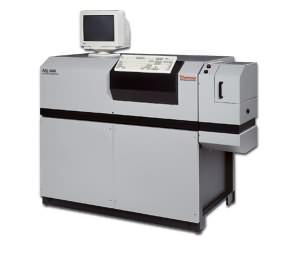|
Instrument Database:
Thermo ARL - ARL 4460 Optical Emission Spectrometer
( Thermo Scientific )
| |
|

|
| |
|
| |
|
| Year of introduction |
|
| Status |
available |
| Company |
Thermo ARL
|
| Categories |
Spectrometer ( Atom. ): AES: Arc/Spark
|
Designed to meet all metals analysis requirements form routine use to metals research, the ARL 4460 is the solution for ultimate analytical performance in varying laboratory conditions or in hostile environments.
- Ultimate detection limits, reproducibility and accuracy
- Speed, accuracy, stability, reliability
- Widest range of metals analysis
- Capability to identify and count inclusions and to calculate cleanness indexes
The ultimate in performance for spark emission metals analysis to allow rapid, reliable quality control of metals.
The ARL 4460 is quite simply the best system for metals analysis produced to date. Two important new capabilities have been added to Thermo Scientific well established spectrometer chassis: The patented Current Controlled Source (CCS), which allows a faster attack on the sample and therefore permits faster analysis times and improved precision of analysis, and the Time Resolved Spectroscopy (TRS) system, which permits clearer differentiation between useful analytical signals and background, therefore allowing better limits of detection to be achieved. Together, these capabilities substantially improve the performance of the OE technique and allow faster analyses (well inside one minute) and improved detection limits for trace analysis.
Even more recently, a new SparkDAT capability has been made available as an option on the ARL 4460. This allows information to be gathered from the individual sparks and permits off-line investigation of "inclusions" in metals.
|
| Specifications |
|
Spectrometer design
One meter, Paschen-Runge vacuum polychromator made of cast iron and temperature controlled to ± 0.1° at 38° C. Maximum 60 channels.
Sample stand
With self contained, recirculating coolant system. Argon flushed table.
Gratings
Spectrometer is provided with one of the following gratings, appropriately selected for the analytical task: 1080 gr/mm, 1667 gr/mm, 2160 gr/mm.
Resolution
Dependent on grating, secondary slit, and spectral order.
Slit widths
Primary slit: 20 µm; secondary slit: 25, 37.5, 50, 75 µm.
Photomultiplier tubes
ø 28 mm, 10-stage side window tubes, fused quartz or glass envelope.
Current Controlled Source (CCS) and Time Resolved Spectroscopy (TRS)
To extend the range of analysis capabilities.
Spectrometer control
ARL MMB 386 Microprocessor utilizing CMOS technology with Status Measuring
Card. A/D converters and attenuators included for each channel. Each attenuator has 41 steps. Up to 12 programmable attenuators are available as an option. The dynamic range of the measuring electronics is proportional to the measuring time, typically 2*106 counts/sec.
Analysis time
Typically less than 45 seconds (for 2 sparks) depending on sample type.
Environmental requirements
Ambient temperature 16-30° C (59-86° F); maximum rate of change ± 5°C/hour;
relative humidity: 20-80%.
Electrical requirements
Voltage 230 V + 10% - 15%, single-phase with protective ground (5 kVA regulator
required if fluctuations exceed ± 10%). Current 12A, frequency 50 or 60 Hz; power 2.5 kVA; grounding < 1½.
In conformity to European directives (89/392/EEC Machinery), (73/23/EEC Low
voltage material), (89/336/EEC Electromagnetic compatibility).
Argon requirements
99.995% maximum 5 ppm oxygen (maximum 2 ppm oxygen for samples with high Si content). Optional argon purifier available and recommended for low carbon
analysis. For nitrogen, argon purifier included. Flow: 5 l/min. during analysis;
0,7 l/min. stand-by.
Enclosure
Built-in dust protection with high capacity cooling fans.
Dimensions
1385 mm (55 in.) wide excluding excitation stand.
1690 mm (67 in.) wide including excitation stand.
1220 mm (48 in.) high, 855 mm (34 in.) deep.
Total system weight
520 kg (1058 lb) approximately.
Accessories and options
- Holders/adapters for small and pin samples.
- Casting molds for ferrous and non-ferrous metals.
- Sample preparation machines for ferrous and non-ferrous metals.
- Argon purification systems.
- Gas distribution system for bottled argon.
- Voltage stabilization systems.
- Window mounted laboratory air-conditioners.
|
|